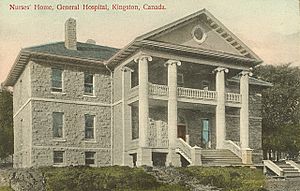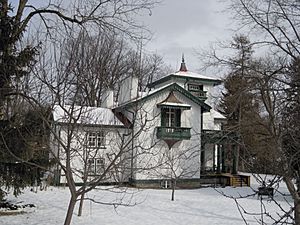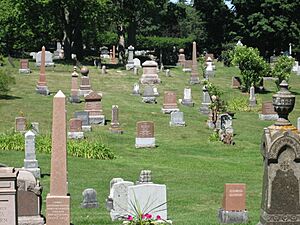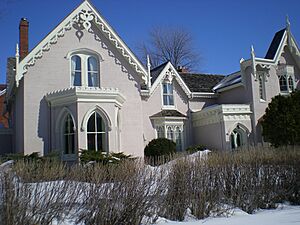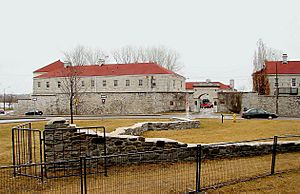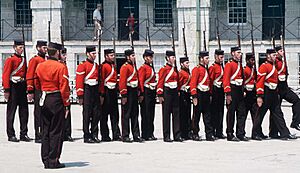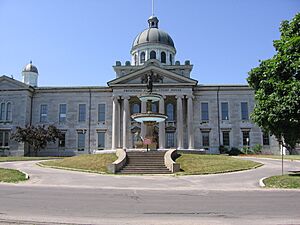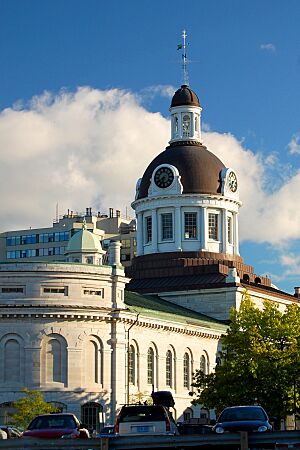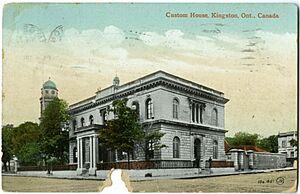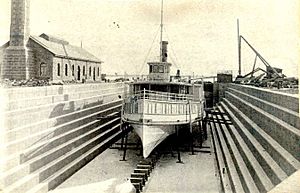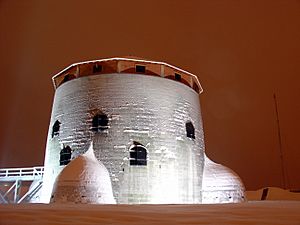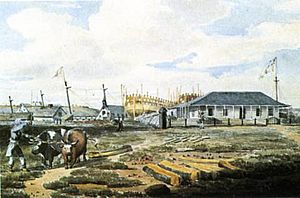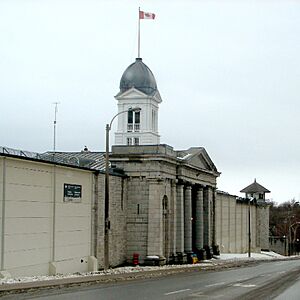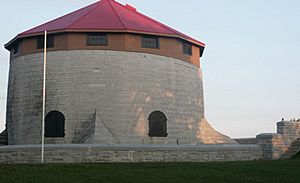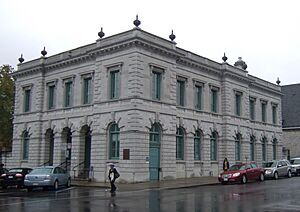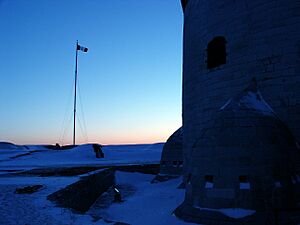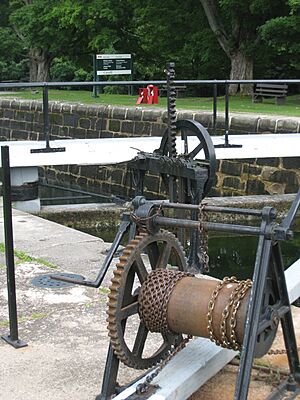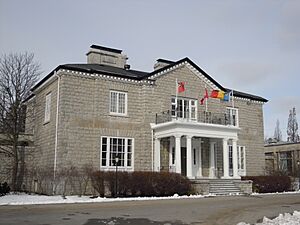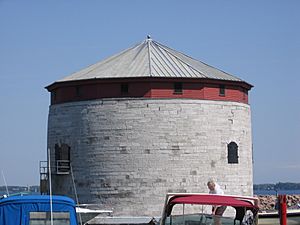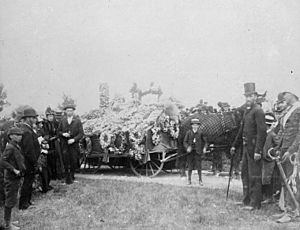List of National Historic Sites of Canada in Kingston, Ontario facts for kids
Kingston, Ontario, is a city full of history! It's home to 22 special places called National Historic Sites of Canada. These sites are recognized because they played an important part in Canada's past. Think of them as historical treasures!
Some of these sites are managed by Parks Canada, like Bellevue House, the Kingston Fortifications, the Rideau Canal, and Shoal Tower. You'll see a small beaver icon ![]() next to the ones Parks Canada looks after. The first sites recognized in Kingston were Fort Henry and Fort Frontenac, both in 1923.
next to the ones Parks Canada looks after. The first sites recognized in Kingston were Fort Henry and Fort Frontenac, both in 1923.
Besides sites, Canada also celebrates important historical events and people. These are often marked with special plaques, just like the sites. You might find plaques for "National Historic Events" or "National Historic Persons" around Kingston too.
Contents
- Kingston's National Historic Sites
- Ann Baillie Building
- Bellevue House
- Cataraqui Cemetery
- Elizabeth Cottage
- Fort Frontenac
- Fort Henry
- Frontenac County Court House
- Kingston City Hall and Market Square
- Kingston Customs House
- Kingston Dry Dock
- Kingston Fortifications
- Kingston General Hospital
- Kingston Navy Yard
- Kingston Penitentiary
- Murney Tower
- Old Kingston Post Office
- Point Frederick Buildings
- Rideau Canal
- Roselawn
- Shoal Tower
- Sir John A. Macdonald Gravesite
- War of 1812 Shipwrecks
- Images for kids
- See also
Kingston's National Historic Sites
Here are some of the amazing National Historic Sites you can find in Kingston:
Ann Baillie Building
The Ann Baillie Building was finished in 1904. It was one of the first buildings in Canada made just for nurses to live in. This shows how nursing became a more professional job in the early 1900s. Today, it's the Museum of Health Care.
Bellevue House
Completed in 1841, Bellevue House is a great example of a beautiful old house style called Italianate. It was once the home of John A. Macdonald, who was a "Father of Confederation" and Canada's very first Prime Minister.
Cataraqui Cemetery
Established in 1850, Cataraqui Cemetery is a beautiful "garden cemetery." It has many interesting monuments and a special building in the Gothic Revival style. Many famous Canadians are buried here, including John A. Macdonald.
Elizabeth Cottage
Elizabeth Cottage was finished in 1843. It's a good example of a 19th-century Gothic Revival villa, which is a type of fancy country house.
Fort Frontenac
The original Fort Frontenac was completed in 1673. It started as a French trading post, a place where people traded goods. It was also a base for explorers like Robert de LaSalle and a French outpost against the Iroquois and English forces.
Fort Henry
Fort Henry was completed in 1840. This British fort was the main defense for Kingston, its harbour, and the start of the Rideau Canal. It's also a UNESCO World Heritage Site.
Frontenac County Court House
The Frontenac County Court House was finished in 1858. It's a large courthouse built in Ontario after 1850. These big buildings were made to handle many different county jobs.
Kingston City Hall and Market Square
Kingston City Hall was completed in 1844. It's a great example of the Neoclassical style, with its famous dome. Its size shows how important Kingston was as the capital of the Province of Canada at that time. The Kingston Public Market, started in 1801, is behind City Hall and is the oldest public market in Ontario.
Kingston Customs House
The Kingston Customs House was finished in 1859. This old customs house is made of limestone. It's a fine example of the quality of public buildings from the mid-1800s, built in the British classical style.
Kingston Dry Dock
The Kingston Dry Dock was completed in 1892. It was a very important place for building and fixing ships on the Great Lakes. Many naval ships, especially corvettes, were built here during the Second World War.
Kingston Fortifications
The Kingston Fortifications were completed around 1840. This system of five forts and towers (Fort Henry, Fort Frederick, Murney Tower, Shoal Tower, and Cathcart Tower) was vital for defending Kingston and the end of the Rideau Canal in the 19th century.
Kingston General Hospital
The historic buildings of Kingston General Hospital were built between 1833 and 1924. It's the oldest public hospital in Canada that is still running. Its buildings show how healthcare changed in Canada during the 1800s and 1900s.
The Kingston Navy Yard was started in 1788. It was a major Royal Navy Dockyard (a place for building and repairing naval ships) from 1788 to 1853.
Kingston Penitentiary
Kingston Penitentiary was established in 1835. It's Canada's oldest reformatory prison. Its design was used as a model for other federal prisons for over a hundred years. Its huge stone wall and north gate are a well-known local landmark.
Murney Tower
Murney Tower was finished in 1846. It's a martello tower (a small, round fort) located on Murray Point. It's also part of the Kingston Fortifications and a UNESCO World Heritage Site.
Old Kingston Post Office
The Old Kingston Post Office was completed in 1859. This two-story limestone building is in the Neoclassical style. It shows how popular Neoclassical elements were in the mid-1800s and how different styles were mixed in early Victorian architecture in Canada.
Point Frederick Buildings
Point Frederick was a major British naval base during the War of 1812. Today, it has many important buildings used by the Royal Military College of Canada. It's also a UNESCO World Heritage Site.
Rideau Canal
The Rideau Canal was completed in 1837. It was built for the British government by Lieutenant-Colonel John By to defend against a possible war with the United States. It's the best-preserved example of a 19th-century canal in North America, with most of its original parts still intact. It's also a UNESCO World Heritage Site.
Roselawn
Roselawn was finished in 1841. It's a two-story Neoclassical house, now used by Queen's University. It represents the large country houses built for wealthy Kingston families just outside the city in the 1800s.
Shoal Tower
Shoal Tower was completed in 1847. It's another martello tower, located on a shallow area in Kingston harbour. It's part of the Kingston Fortifications and shows Kingston's military importance in the 19th century. It's also a UNESCO World Heritage Site.
Sir John A. Macdonald Gravesite
The Sir John A. Macdonald Gravesite is where Sir John A. Macdonald was buried in 1891. He was a "Father of Confederation" and Canada's first Prime Minister. His grave is located in Cataraqui Cemetery.
War of 1812 Shipwrecks
These are the wrecks of British ships from the War of 1812, including the Saint Lawrence, Princess Charlotte, and Prince Regent. They were built in 1814 and are found in Deadman Bay and other spots around Kingston.
Images for kids
See also


